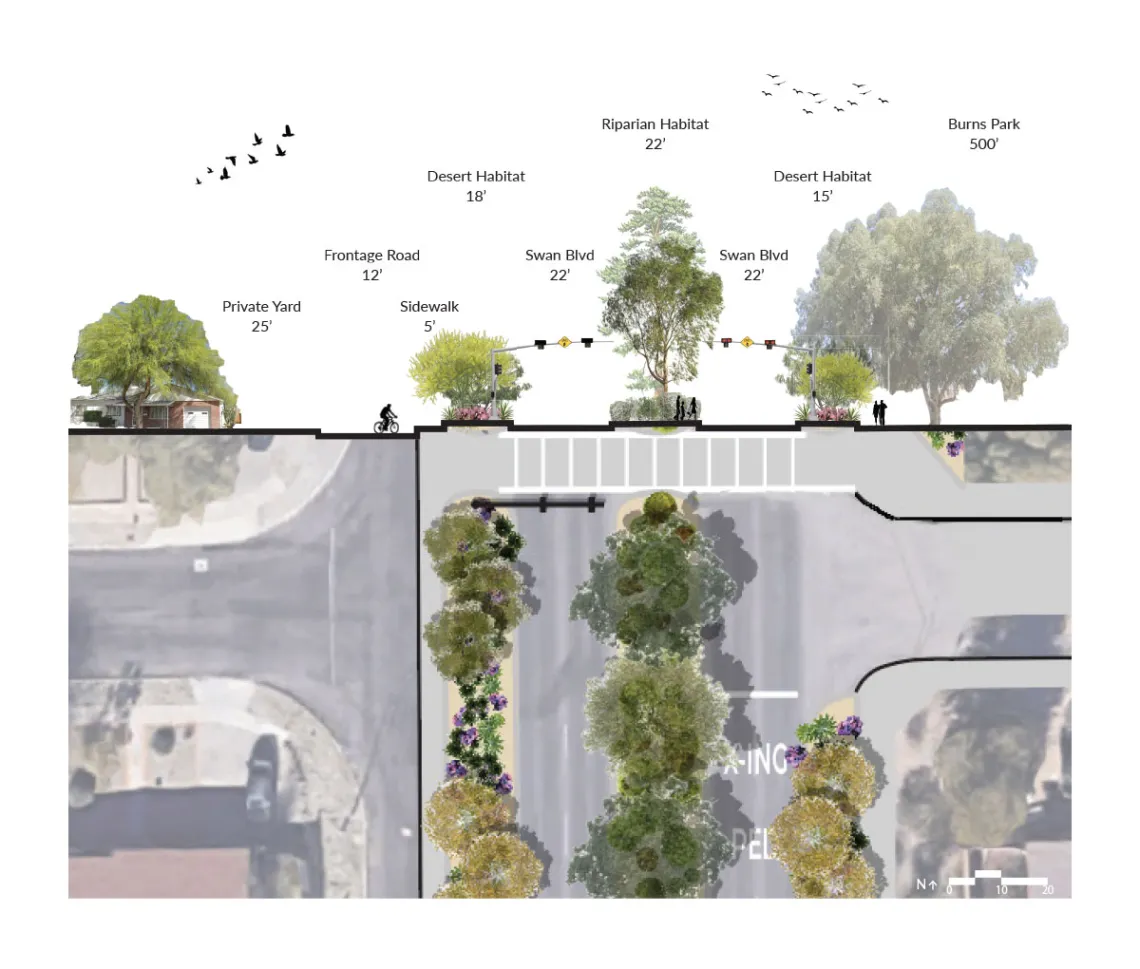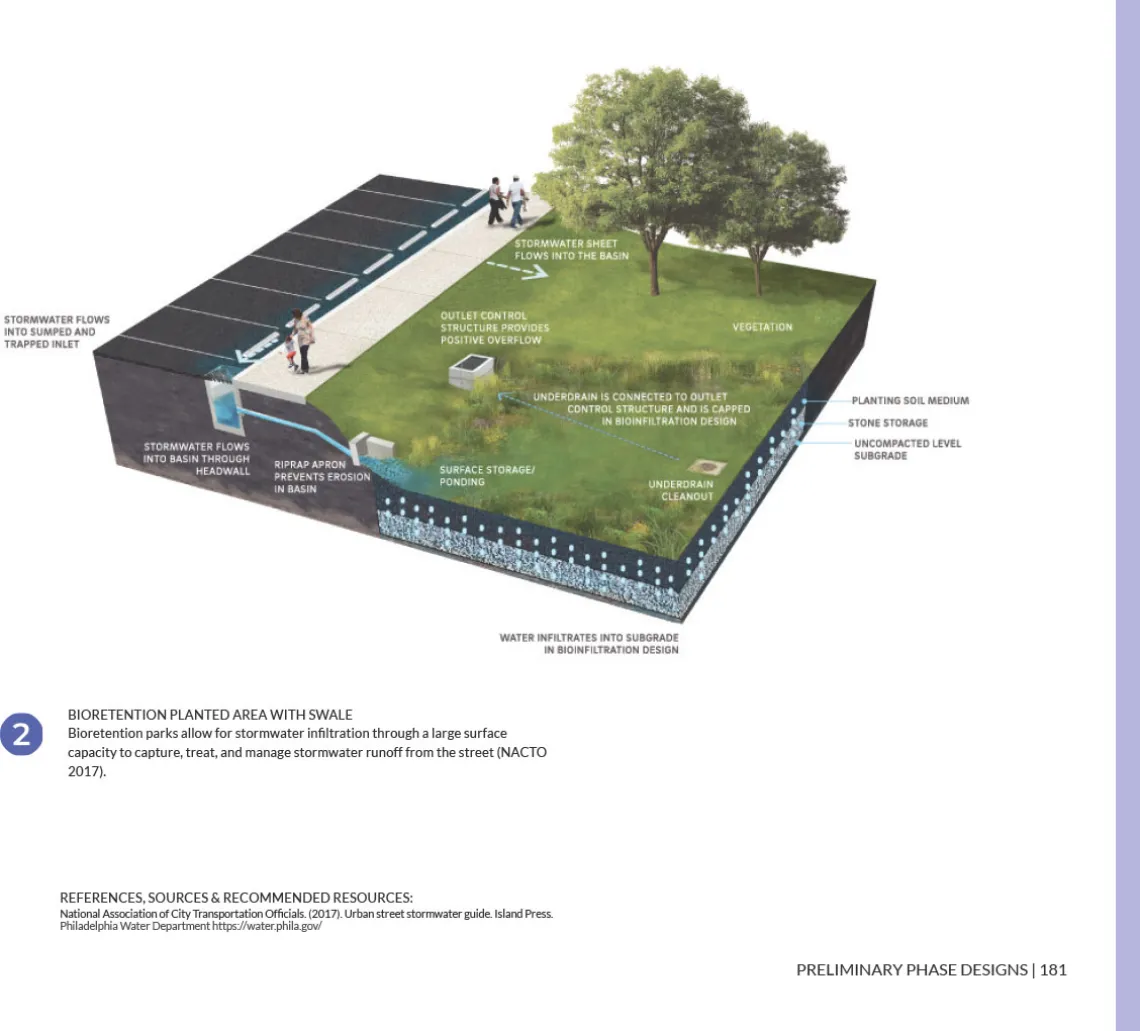Sonoran Birds and Climate Change: UArizona Landscape Architecture Students Work with Community to Design Urban Bird Habitats

Revive Connections, a Sonoran Birds + Climate Change studio design by Nadia Sarneyzeh Doost '23 MLA.
In a collaborative effort between students in the University of Arizona’s Master of Landscape Architecture program and key community organizations, the recent Sonoran Birds + Climate Change studio took on the task of reimagining a small neighborhood park in Tucson’s Sierra Estates neighborhood.
Led by Assistant Professor of Landscape Architecture Mackenzie Waller, the studio aimed to create designs that not only cater to the needs of the community but also prioritize the protection and enhancement of urban bird habitat.
Waller and landscape architecture students in the College of Architecture, Planning and Landscape Architecture worked with Tucson Audubon Society and Tucson Clean and Beautiful, while leadership from the Sierra Estates neighborhood played a vital role in supporting the efforts of the students throughout the design process.

Site ecology for the Burns Park project. Image courtesy Mackenzie Waller.
“During this studio, students created designs for urban bird habitat that are functional while also prompting curiosity and wonder from their human neighbors,” says Waller. “The students’ designs offered site-based solutions that connect to larger regional challenges driven by climate change and urbanization.”
The students’ designs for the proposed Burns Park resulted in much more than site-specific bird habitat, says Nichole Casebeer, green infrastructure program manager for Tucson Clean and Beautiful: “The students were extremely compassionate and left a deeply positive mark in the community through the project—both in the relationships they built and the ideas they generated. They were great listeners and worked very thoughtfully to integrate the needs and concerns of residents.”
The park designs speak to several diverse neighborhood goals, including protecting resident hawks that nest in the tall trees on the site, calming neighborhood traffic and evaluating the addition of a fenced dog park.

TucsRouken: The Oak Woodlands Stroll Park, a design for Burns Park by the Sonoran Birds + Climate Change studio. Image by William Glockner.
In considering holistic approaches, students first divided into three teams, each creating near-term, cost-effective plans that were shared with neighbors. Students then developed “bird-sized” models or other unique, hand-built habitats for individual bird species in consultation with local artist Greg Corman. For instance, second-year MLA student Selenne Yescas created a feeder for the common raven that relies upon the bird’s exceptional intelligence to “trade trash for food,” while other students crafted models for such species as the red-tailed hawk, cactus wren, lesser goldfinch, broad-billed hummingbird, Western screech owl, curve-billed thrasher and Gambel’s quail. “Greg Corman gave each of us materials he suggested we use for our models,” says Krista Planinac, a second-year MLA student., “His generosity and guidance were a highlight of the studio for me.”
“One of our design goals was also to integrate elements that were already onsite,” says Yescas of her team’s project. “For instance, there were concrete curbs for parking discarded on the side of the road. We asked how we could reuse these to create something distinct and useful for the actual site.”
The students demonstrated that good design means more than accounting for individual bird species and materials reuse, however.

Image by Selenne Yescas.

Common raven habitat prototype. Images by Selenne Yescas.
“The Sonoran Birds + Climate Change project successfully demonstrated that creating bird-friendly design in urban landscapes yields far-reaching outcomes that extend beyond improving bird habitat,” says Kari Hackney, urban habitat restoration manager at Tucson Audubon Society. “Urban bird habitat improves habitat for other wildlife, mitigates issues such as flooding and the heat island effect, and also brings the benefits of wildlife watching to the public.”
“I enjoyed getting out of my comfort zone,” says second-year MLA student Jessica Eppard. “There were so many parts of this studio project that were different from anything we had done before—like actually presenting to the community and physically building elements of the bird habitat we designed.”
For many of the students, it was the first time they had worked in CAPLA’s world-class Materials Labs, often consulting with CAPLA architecture students as they designed and constructed individual bird habitats.

Parklet Palette: Resident Style, by Waverly Brown.
“Working on this project increased my confidence as a critically thinking designer,” says Planinac. “We were required to bring research and rigor into our designs, which was an uncomfortable place to be at times. This allowed each of us to grow and cultivate a better sense of who we are as individual designers and as a cohort, and ultimately how we want to contribute to the profession.”
Though individual design was important, for MLA student Nadia Sarneyzeh Doost the collaborative effort has also left a lasting impact. “Taking part in this kind of team project as an international student was an amazing experience for me,” she says. “Everyone had something to contribute, and each person was able to bring their own unique perspective to the project.”
“In the end, I know the residents felt heard and are excited about next steps,” concludes Casebeer. “Many dimensions of the students’ work will be implemented. Our neighborhood partners were engaged and supported through this collaboration in a way that our program’s resources alone couldn’t accomplish. It was a real joy to see everyone connect and come together to address real neighborhood concerns with thoughtful, ecological and community-centered solutions.”
Studio Report
Image Gallery
Click an image to view in larger size and begin slideshow:
Students
- Zach Andre
- Waverly Brown
- Blake Caldarera
- Jessica Eppard
- William Glockner
- Cordell Lee
- Will Leipold
- Krista Planinac
- Oscar Rodriguez Ponce
- Nadia Sarneyzeh Doost
- Selenne Yescas

UArizona Master of Landscape Architecture students who participated in the Sonoran Birds + Climate Change studio, Fall 2022. Photo courtesy Selenne Yescas.
Faculty Lead
- Mackenzie Waller, Assistant Professor of Landscape Architecture, UArizona
Studio Review and Support Team
- Nichole Casebeer, Green Infrastructure Program Manager, Tucson Clean and Beautiful
- Greg Corman, Artist, Designer and Botanist
- Catherine De Almeida, Assistant Professor of Landscape Architecture, University of Washington
- Kari Hackney, Urban Habitat Restoration Manager, Tucson Audubon Society
- Kenneth Kokroko, Assistant Professor of Landscape Architecture, UArizona
- Shujuan Li, Associate Professor of Landscape Architecture and Urban Planning, UArizona
- Kathleen Prudic, Assistant Professor of Citizen and Data Science, UArizona
- Erik Schmahl, Adjunct Lecturer in Landscape Architecture, UArizona
- Bret Smith, Materials Labs Manager, UArizona
- Olya Weekley, Applied Conservation Project Manager, Tucson Audubon Society
- Kenny Wong, Lecturer in Sustainable Built Environments, UArizona
Learn more about the UArizona Master of Landscape Architecture program, or explore how you can support students in their work with the community.











































